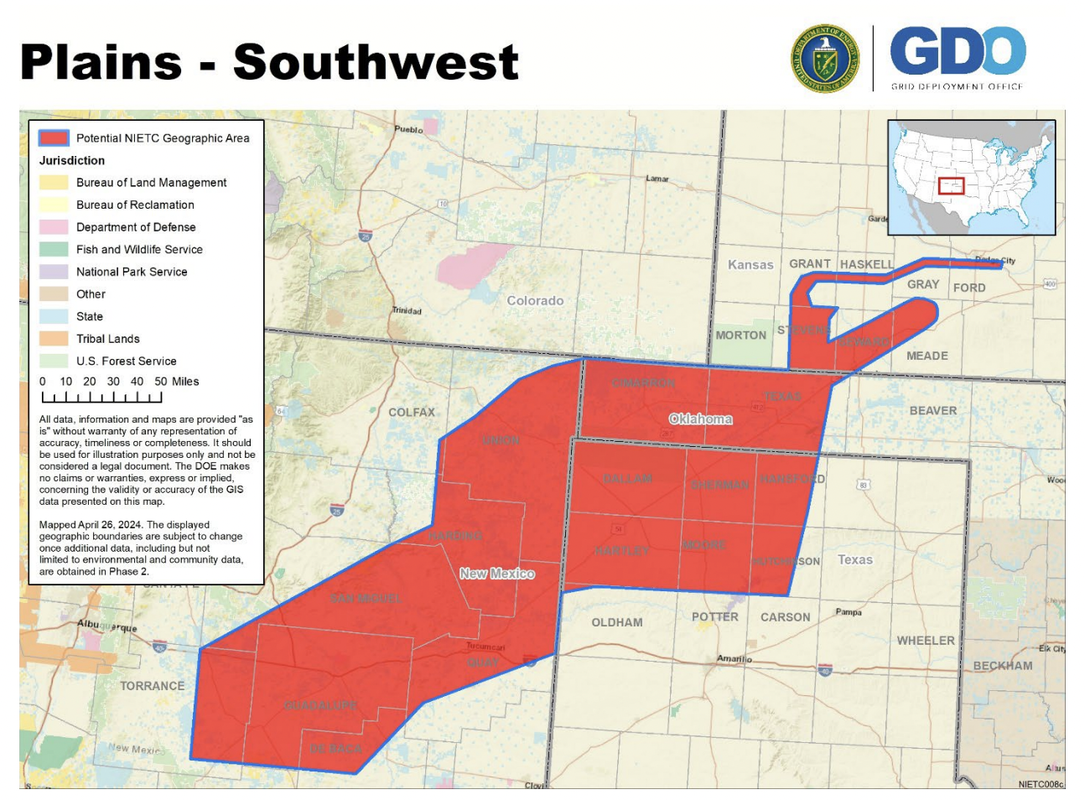A NIETC's purpose is to designate a geographic area where one or more transmission projects serving the "national interest" can be sited. A transmission project inside an NIETC can apply for a federal permit and eminent domain if its state application is denied. NIETCs are a way to overturn a state decision you don't like.
But GBE claims to have all the state approvals it needs. So, why the corridor?
Why is it 5-miles wide?
And what ever happened to GBE's Environmental Impact Statement being prepared by the U.S. Department of Energy's Loans Program Office to facilitate a "get out of debt free" card provided by taxpayers if GBE cannot repay its loan?
All these questions (and more!) were answered recently, and the answers did not come from DOE. DOE has put its interactions with greedy transmission developers under lock and key. No, the information came from another (anonymous) source whose accuracy can be trusted.
The Midwest Plains Preliminary NIETC was submitted to DOE by GrainBelt Express (GBE) as a National Interest Electric Transmission Corridor because of the federal funding opportunities that a NIETC designation opens up, as well as the potential last resort option of the use of federal backstop siting authority in States where the initial state approval is currently under appeal, such as Illinois. The corridor was originally submitted as five miles in width because GBE thought that it had to be at least wide enough to encompass two lines.
Because of all the stink you made, GBE has submitted comments to DOE requesting that the corridor be substantially narrowed to no wider than is necessary to site just the GBE line.
But would a narrow, specific "corridor" that only enables one transmission line actually be something that DOE can do? It positively smacks of government graft. Wouldn't a wider corridor give the DOE plausible deniability? It seems like the DOE was only too happy to create a 5-mile wide corridor (which is supposed to be based on DOE's factual transmission needs study, btw, not greedy requests). Who knows what DOE will do with this corridor in the fall. Will they stick with their 5-mile wide corridor, or will they prove that they are nothing more than a corporate puppet by granting GBE's second request to narrow the corridor just wide enough for GBE?
If designated this fall, this NIETC will have to undergo a federal Environmental Impact Study, just like the one GBE is already involved in required by its request for a government loan guarantee. But the study already underway only studies the very narrow GBE corridor. It doesn't study a 5-mile wide NIETC. If the NIETC is any wider than GBE itself, then GBE's EIS will have to go back to start. But perhaps that is required in any instance, since the basis for the EIS and governmental action will have changed completely between a government loan guarantee and a NIETC. You could probably litigate on changing purpose in midstream for a long time. Maybe GBE will have to fund two separate EIS reports, one for each purpose? Each EIS takes a minimum of two years.
Meanwhile, back at the DOE, the right hand has no idea what the left hand is doing. Don't these gals ever see each other in the hallways and stop to chat? Maybe not because they are all likely "working from home". I hear that nobody answers the phone at DOE HQ anymore. Is any work being done in that empty building we pay for?
DOE says the LPO (Loans Program Office) will publish the draft EIS for public review and comment this winter. DOE is plunging ahead with the EIS for the loan, while not even acknowledging another one has to be done for the NIETC designation. At least they're only wasting GBE's money with this duplication of effort. Carry on, ladies!
And here's another thought brought on by the preliminary NIETC designations. GBE's western terminus will be in Ford County, Kansas. We've been told that for years. The story goes that GBE will ship all that untapped wind energy in Kansas to "where it's needed most" (Mars? Polsky's imagination? Lifestyles of the Rich and Famous?). GBE is now asking for approval of two "collector lines" in southwestern Kansas for wind AND solar projects not yet built. See KCC docket 24-GBEE-790-ST available at this link for more info.
Kansas, huh? Then what is the Plains - Southwest NIETC for, and why does it reach its cold little finger up into Ford County Kansas? Is it trying to export even more Kansas wind, or is it importing wind from other states that will be shipped through Kansas on GBE?
Anyhow... maybe, just maybe, the longer this debacle goes on, the GBE koolaid that some of the project's biggest cheerleaders ingested seems to be wearing off. Wakey, wakey, little officials! There's a wolf among your sheep!


 RSS Feed
RSS Feed